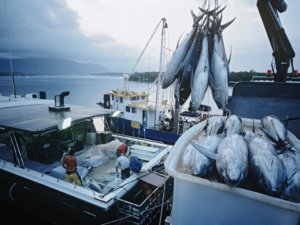Maritime employees who work on fishing trawlers and factory ships are exposed to dangerous situations on a daily basis. Some hazards, like rough seas and inclement weather, are accepted risks that seamen must take into account. However, hundreds of deck bosses, deck hands, packers, and mates are injured or killed annually due to working too many hours, strenuous activity, and unsafe working conditions aboard trawlers or fish processing vessels. Frequently, seamen who are injured on the job due to their employers’ negligence end up with disabilities that limit their ability to work and reduce their earning capacity.

Hazards Involving Fish Processing Equipment
Commercial fishermen ply their trade in many different parts of the world’s oceans. Many fishing trawlers and factory ships operate in places such as the Bering Sea, an arm of the north Pacific Ocean off the coasts of Russia and Alaska. The Bering Sea is notorious for its rough seas and many days of bad weather, but it is where much of the seafood consumed in the U.S. is harvested and processed.
As a result, crew members of a deep-sea fishing trawler or factory ship face many hazards which are made worse by heavy seas and inclement weather. In addition to long working days that average between 12 and 16 hours of job-related activity, fishing industry seamen have to contend with a number of potential hazards. These include:
- Physical hazards
- Biological hazards
- Exposure to heat and cold
- Exposure to noise and vibrations
- Exposure to chemicals
- Lifting, carrying, and repetitive injuries
- Confined space
Physical Hazards
Physical hazards are among the most common causes of accidents related to fish processing equipment. Slips, falls and trips on slippery decks and other surfaces are frequent aboard trawlers and factory ships. In addition, processing machinery has components with sharp corners like those present in stainless steel basins. Workers are also at risk of getting cut by the arrays of knives or other sharp tools needed to prepare fish for the freezing and packing processes .
Biological Hazards
Workers involved in seafood processing handle large numbers of fish on a daily basis for extended period of times. Manual activities, such as skinning or gutting fish, can trigger allergic reactions or allow skin infections to develop due to exposure to fish or any bacteria on the fish. In addition, workers often inhale bacteria as a result of water spraying methods which create a misty aerosol effect in the enclosed spaces of the ship..
Common Injuries Caused by Fish Processing Equipment
Processing fish and other seafood products is dangerous because much of the work requires equipment with cutting blades and sharp metal edges. Factory ships are fitted with bait choppers, salmon headers, automatic deheaders to remove fish heads and tails, knives, and augers. As a result, the most common non-fatal injuries among workers who process fish are cuts, penetrating wounds, scratches, and amputations of arms, hands, or digits.
Other injuries to workers’ hands and arms include:
- Frostbite
- Fractures or cuts caused by heavy boxes of frozen seafood
- Puncture wounds from fish spines
- Cuts or fractures caused by conveyor belt accidents
According to the National Transportation Safety Board (NTSB) workers on fishing trawlers or factory ships often suffer fractures to the arms and legs. Head and neck injuries are also among the most frequently reported non-fatal injuries among commercial fishermen.
Maritime workers injured on the job aboard a commercial trawler or factory ship which processes seafood are eligible to receive compensation under the Jones Act if the ship’s owner, captain, or other crew member was negligent and contributed to the injury. Experienced maritime attorneys can assist commercial fishermen in a Jones Act lawsuit if the vessel is unseaworthy or if the owner and/or operator did not take necessary steps to provide crew members with a safe work environment.